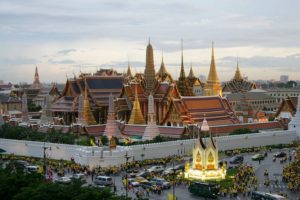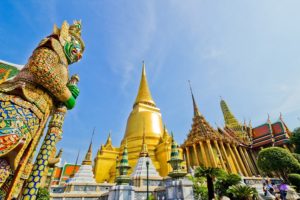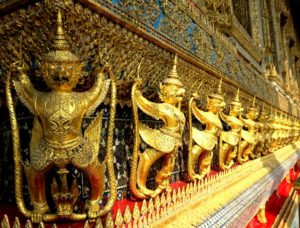 Visiting everything Bangkok has to offer on what may perhaps be a short trip to Thailand, can be somewhat challenging. However, one of Siam’s most coveted landmarks and a special place in the heart of many Thais which should not and must not be missed, is the spectacular Grand Palace.
Visiting everything Bangkok has to offer on what may perhaps be a short trip to Thailand, can be somewhat challenging. However, one of Siam’s most coveted landmarks and a special place in the heart of many Thais which should not and must not be missed, is the spectacular Grand Palace.
This historical and famous landmark was built in 1782 by the Thai people, and has become an excellent reflection of the intricate creativity and craftsmanship of the warm, always smiling Siamese population.
 The Grand Palace has been home to Thai Royalty for an incredible 150 years till the turn of the 20th century when the king stopped living in the majestic grounds to live in a more homely royal palace in Hua Hin. The grand palace was before the 20th century not only home to the Thai Royal family but also had the royal court, the administrative seat of government, the Thai war ministry and other important state departments which make it today what many would call the spiritual heart of the incredible Kingdom of Thailand.
The Grand Palace has been home to Thai Royalty for an incredible 150 years till the turn of the 20th century when the king stopped living in the majestic grounds to live in a more homely royal palace in Hua Hin. The grand palace was before the 20th century not only home to the Thai Royal family but also had the royal court, the administrative seat of government, the Thai war ministry and other important state departments which make it today what many would call the spiritual heart of the incredible Kingdom of Thailand.
 Due to its significant historical role in Thai Governance, the opening of the palace has blessed us all with the opportunity of being able to observe and enter the grounds of a place where major decisions have been made by highly important personalities. The palace complex is as vast as a castle can be in the imagination of a peasant; its beautiful architecture, its similarity to other Thai historical places such as the Ayutthaya layout, and the focus on intricate details throughout the vast grounds is a must-see to truly appreciate what Thailand is about; deep rooted culture, intricacy in details and rich aesthetic value in every presented creation.
Due to its significant historical role in Thai Governance, the opening of the palace has blessed us all with the opportunity of being able to observe and enter the grounds of a place where major decisions have been made by highly important personalities. The palace complex is as vast as a castle can be in the imagination of a peasant; its beautiful architecture, its similarity to other Thai historical places such as the Ayutthaya layout, and the focus on intricate details throughout the vast grounds is a must-see to truly appreciate what Thailand is about; deep rooted culture, intricacy in details and rich aesthetic value in every presented creation.
Within the palace ground too lays the Temple of the Emerald Buddha (Wat Phra Kaew) which dates all the way back to the 14th century. An incredible large laying Buddha under the protection of a relatively small space found in what is known as the outer court. Interestingly enough, the robes of the laying Buddha are changed yearly by the reigning monarch, an important ritual in the Buddhist calendar. The Outer Court, which is near the entrance, used to be the area housing government departments such as the civil administration, the army and the treasury which the king used to be directly involved with. The Central Court on the other hand is the area where the residence of the King used to be as well as where halls used for carrying out state business were once located. Finally the Inner Court is where the royal consorts and the king’s daughters used to live, an area which in the past was known to be a small city populated entirely by women and children. Although royalty no longer lives in this inner most court, the entrance is still closed off completely to the public.
It is not in many places where one can so closely re-live the ways of the monarchy; The Grand Palace is the place to be for Thai history and culture to be truly lived and a sight to certainly be seen when visiting Bangkok.


